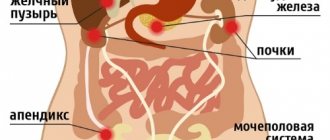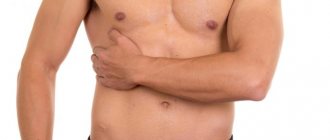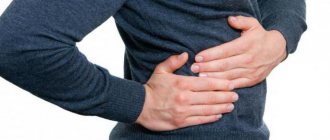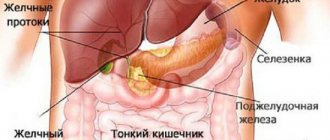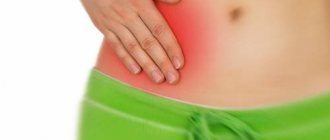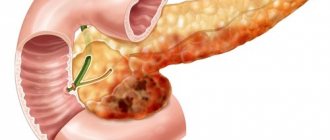The cause of discomfort in the right hypochondrium is most often gastroenterological pathologies. They require urgent medical intervention. In this article we will look at the main factors that cause heaviness in the right side under the ribs in the front, middle and back.
Almost always, a feeling of fullness in the right hypochondrium signals the development of a dangerous disease.
General information
The right hypochondrium refers to the area of the anterior abdominal wall.
Table 1. What is the right hypochondrium limited by?
| Above | Diaphragmatic projection (5th rib). |
| From below | The lower border of the ribs and arches. |
| Interior | A line passing vertically through the point of the ribs, which is located at the very bottom. |
| External part | A line extending vertically from the iliac crest. |
What organs are there?
Pain may come from nearby organs
The following organs are located in the right hypochondrium:
- adrenal;
- liver;
- peritoneal portion of the right half of the diaphragm;
- gallbladder;
- flexure of the colon;
- the upper part of the right kidney.
Note! Discomfort that occurs in the right hypochondrium can radiate from the bile ducts, duodenum, inferior vena cava and pancreas.
In what cases is treatment necessary?
Pressing sensations in the right hypochondrium are usually one of the first to appear among the symptoms of the disease. With the development of pathology, the clinical picture is complemented by signs characteristic of a specific provoking disease.
You should visit a doctor when the following are added to the heaviness in the peritoneum:
- heartburn;
- heat;
- dizziness;
- bitterness in the mouth;
- problems with urination;
- change in the color of urine or stool;
- prolonged diarrhea and vomiting;
- cough;
- dyspnea;
- blood pressure surges;
- unreasonable weight loss;
- increased sweating;
- fast fatiguability;
- itching;
- swelling;
- yellowness or paleness of the skin.
An ambulance should be called if severe abdominal pain lasts longer than 30 minutes!
It is not advisable to take painkillers before the medical team arrives - this can “blur” the symptoms and complicate diagnosis.
It is strictly forbidden to apply a heating pad to your stomach!
Pathological causes
Prolonged heaviness and discomfort in the right side are caused by:
- liver diseases;
- pathologies of the gallbladder and ducts;
- kidney diseases;
- neurological disorders;
- impaired blood circulation.
Most common reasons
The table presents the factors that most often provoke the occurrence of heaviness in the right hypochondrium.
Table 2. Common triggers.
| Pathology | Description | Associated symptoms |
| Usually discomfort occurs on the left side. On the right, heaviness appears against the background of inflammation of the head of the pancreas. There is pain from the back, which increases over time. | The person becomes weak, lethargic, drowsy. Efficiency is lost. When the disease progresses into the acute phase, nausea appears, transforming into vomiting, which does not bring relief. The temperature rises, the sclera of the eyes turn yellow. |
| Pathology of the duodenum. It is the most common cause of heaviness in the right hypochondrium after eating. In addition to the feeling of fullness, there is a cramping pain radiating to the scapula on the right side. Symptoms increase within 120 minutes after eating. | Bitterness in the mouth, heartburn, nausea, bitter belching. If the disease is not treated and progresses, there is a rapid heartbeat and increased sweating. Abnormal bowel movements are observed. Diarrhea occurs more often. The person becomes weaker and has tremors. |
| Heaviness under the ribs occurs in the middle. The feeling of fullness gradually transforms into pain. It may radiate to the scapula or shoulder. | Within 24 hours an attack of biliary colic appears. A person feels sick and vomits, but vomiting does not bring him relief. The temperature rises to 38 degrees. |
| The feeling of fullness is accompanied by specific tingling sensations. | Bloating, nausea, increased heart rate. |
| The disease is an inflammatory process occurring in the bile ducts. The feeling of fullness is accompanied by a mild pain syndrome. | Bloating, fatigue, weakness. |
| The inflammatory process affects the paroxysmal part of the duodenum. The feeling of heaviness is combined with aching pain that radiates to the area near the navel. Symptoms increase within 120 minutes after eating. | Nausea and belching. A specific bitter taste remains in the mouth. During an exacerbation, the patient’s performance decreases, muscles weaken, and severe tremors are present. |
| A feeling of heaviness occurs after waking up, before breakfast. Discomfort is combined with pain, which can be either dull or cramping. Some people have a feeling of a “stake inside”. | Bloating, sour belching. A person may feel nauseous and sometimes vomit. |
Liver problems
The diagram shows the main reasons for the feeling of fullness in the right side under the ribs.
The main cause of heaviness in the hypochondrium on the right is hepatitis
Note! As a result of the development of these pathologies, bile stagnation is formed, which contributes to disruption of liver function. Complete organ failure leads to death.
Other causes of heaviness in the liver are presented in the table.
Table 3. What causes the feeling of fullness?
| Pathology | Cause | Description | Additional signs |
| Increase in blood bilirubin. This is due to the formation of a tumor in the liver or the appearance of stones in the bile ducts. Another provoking factor is the destruction of a large number of red blood cells. | Jaundice is almost always a symptom of some other disease. | Changes in the shade of the skin and whites of the eyes. The temperature rises, nausea appears, and sometimes vomiting occurs. Heaviness in the liver occurs after eating. The color of the urine changes to darker. |
| Penetration of a virus into the body, promoting the development of an acute form. | In the absence of medical care, the disease transforms into cirrhosis or fibrosis. | The disease “hides” for a long time and has no specific symptoms. Heaviness in the right hypochondrium may be the only sign. As hepatitis progresses, symptoms of jaundice appear. Body temperature rises There is no appetite, the limbs and face are swollen. |
| Bone marrow surgery, green tea abuse, consequences of chemotherapy. | Heaviness under the right rib in the front develops with an edematous liver. | Symptoms of jaundice, rapid weight gain, ascites. |
Diseases of the bile ducts and bladder
The reasons for the appearance of heaviness in the right hypochondrium are indicated in the diagram.
A common cause of discomfort is cholecystitis.
Kidney diseases
One of the causes of this syndrome is urolithiasis.
The cause of the feeling of fullness under the ribs from the back may be:
- acute upper paranephritis;
- urolithiasis disease;
- kidney cancer;
- right adrenal cancer.
The feeling of fullness is almost always accompanied by acute pain.
Neurological pathologies
With various neurological disorders, signs appear that are similar to those of liver pathologies. The feeling of heaviness is accompanied by spasmodic or burning pain in the back and lower back.
Note! In 82% of cases, a feeling of fullness in the hypochondrium on the right is provoked by intercostal neuralgia. The symptoms of this pathology are similar to those of cholecystitis.
The incidence of other neurological pathologies accompanied by a feeling of heaviness is indicated in the diagram.
The cause of the feeling of fullness may be osteochondrosis
Circulatory disorders
Against the background of heart failure and cirrhosis, the development of collateral venous congestion is observed.
Nodular neoplasms of the liver put pressure on the blood vessels. This leads to accumulation of blood in the organ. The feeling of fullness is caused by the expansion of the liver.
Etiology
The sources of the feeling of fullness are usually divided into several large groups. The first category is represented by diseases and pathological conditions, and the second includes sources not related to the course of a particular disease.
In the vast majority of situations, the provocateurs are:
- bile duct dyskinesia;
- cholecystitis in acute or chronic form;
- liver echinococcosis;
- viral hepatitis;
- formation of stones in the kidney or ureter;
- cirrhosis of the liver;
- malignant or benign neoplasms localized in the abdominal cavity;
- intestinal obstruction;
- chronic pancreatitis;
- ulcerative type of duodenitis;
- nephroptosis;
- occlusion of the liver veins;
- osteochondrosis of the lumbar spine;
- intercostal neuralgia;
- various injuries and bruises;
- inflammatory lung disease;
- intestinal dysbiosis;
- irritable bowel syndrome;
- pyloric stenosis;
- gastritis;
- celiac disease;
- renal colic;
- pyelonephritis;
- inflammatory lesion of the appendix.
Distension in the right hypochondrium or on the left side of the lower part of the ribs often develops in a completely healthy person. Provocateurs for this may be:
- prolonged effects on the body of low temperatures, even for a short period of time;
- long-term addiction to bad habits, in particular, drinking alcohol;
- excess body weight;
- poor nutrition, excess fatty foods and sweets on the menu;
- prolonged refusal to eat followed by overeating;
- swallowing large amounts of air during meals.
Often this situation, in which there is swelling under the ribs, develops against the background of the consumption of certain products that cause increased gas formation in the gastrointestinal tract. Provocative ingredients include:
- legumes;
- White cabbage;
- prunes;
- milk products;
- carrot;
- grains enriched with fiber;
- sweets and baked goods;
- carbonated drinks;
- potato.
Absolutely all of the above provocateurs can have an effect on both adult patients and children.
A similar symptom also quite often appears in females during pregnancy. Moreover, its occurrence can be due either to the above reasons, or to the active growth of the uterus and fetus inside the womb. In the second case, the internal organs of the peritoneum are displaced into the chest cavity.
What should I do?
When the first alarming symptoms appear, you should seek help from a doctor as soon as possible.
After the initial examination, the therapist may refer the patient to:
- gastroenterologist;
- nephrologist;
- surgeon;
- cardiologist;
- vertebrologist;
- traumatologist
Primary diagnosis
The table presents methods of primary diagnosis.
Table 4. What does the doctor do first?
| Doctor's action | Description |
| This helps to identify the root cause. |
| The method is necessary to confirm or refute exposure to non-hazardous sources. |
| The specialist assesses the condition of the skin, sclera, and mucous membranes. Then the doctor carefully palpates the anterior wall of the peritoneum. |
| Temperature and heart rate indicators are also measured. |
Secondary diagnosis
Auxiliary diagnostic methods are presented in the table.
Table 5. Features of secondary diagnostics.
| Laboratory research | Instrumental diagnostics |
| PCR and hormonal testing, liver tests, stool examination under a microscope, biochemical blood test, general clinical blood and urine tests. | Ultrasound examination of the abdominal organs, MRI, CT, ECG, endoscopy. Gastroscopy is also performed. If necessary, the patient undergoes a biopsy. |
Providing first aid
You can relieve discomfort without medications using a compress
The instructions look like this:
- Take a horizontal position and try to calm down.
- If a feeling of fullness in the right hypochondrium is accompanied by swelling in this area, vomiting and severe pain, you should call an ambulance as soon as possible. This symptom may indicate inflammation of the appendix.
- If a feeling of heaviness in the right hypochondrium is accompanied by aching pain, you can place a compress on the sore area. It is recommended to apply a cold towel or ice pack.
- If the pain does not disappear, you can take 1 tablet of No-shpa. This drug is not recommended for those with hypersensitivity to sodium metabisulfite.
- You can relieve severe pain with a glass of heavy cream. The liquid flows around the gastric walls, preventing the acidic secretion from irritating its surface.
Note! Until the exact cause of discomfort is determined, it is not recommended to take any other medications other than No-shpa.
Drug therapy
The tablet describes the features of drug therapy.
Table 6. Drug treatment.
| Pathology | What medications are prescribed? |
| Antiviral drugs, detoxifying drugs, anticholestatics, glucocorticosteroids, hepatoprotectors. |
| Analgesics, anti-inflammatory drugs, chondroprotectors. |
| Beta-blockers, antiplatelet agents, vasodilators. |
Surgery
The doctor resorts to surgical intervention when:
- inflammation of the appendix;
- complications of gallstone disease;
- various tumors.
In case of acute pancreatitis, urgent surgery is prescribed. The cost of delay can be very high.
Prevention methods
You need to stay healthy at any age, and the key to this condition is the right lifestyle. With regard to diseases of the liver, kidneys and digestive system - the most common causes of pain in the right side, it is important to follow the rules of nutrition. Including healthy foods, vegetables, fruits, gifts of nature and the sea in your diet will protect you from many diseases, increase stamina and resistance to infections, general tone and mood.
If you already have chronic pathologies, you cannot do without following a diet. The attending doctor will tell you about it; general recommendations include:
- exclusion of spicy, fatty and fried foods,
- reducing the consumption of salt and sugar, carbohydrates.
Stick to a meal plan - often, in small portions. This approach to nutrition will prevent the exacerbation of chronic pathologies, stabilize the patient’s weight, improve metabolic processes, and normalize the synthesis and outflow of bile. This will allow all internal organs to work in the correct mode.
Folk remedies
Herbs that can relieve heaviness in the liver area are presented in the table.
Table 7. The most effective herbs.
| Means | What does it help with? | What is better to combine with? | What to cook? |
| Intoxication, serious liver dysfunction. | With Sarepta mustard seeds, medicinal dandelion flowers, white willow bark. | Decoction. |
| Elimination of heaviness on the right side of the abdomen, relief of spasms. | With golden sarothamnus herb, calendula flowers, coriander fruits, caraway seeds. | Infusion. |
| Diseases of the liver and gall bladder. | — | Tea. |
| Liver diseases. | With plantain, rose hips. | Decoction. |
| Liver diseases. The herb promotes tissue repair. | Hop cones. | Decoction. |
Note! After treatment of the liver and gallbladder, it is recommended to drink oatmeal jelly.
The duration of herbal medicine is 90 days.
Preventive recommendations
The most important preventive recommendation is to control your weight
You can avoid the appearance of an unpleasant symptom if:
- to live an active lifestyle;
- undergo regular examination;
- eat well;
- control your condition after stress;
- Avoid gaining extra pounds.
